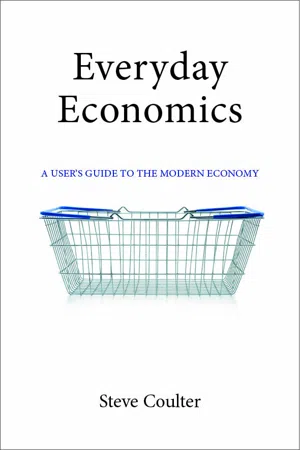Economics
Banking
Banking refers to the industry and practice of accepting deposits, lending money, and providing financial services. Banks play a crucial role in the economy by facilitating the flow of funds between savers and borrowers, and by offering various financial products such as loans, mortgages, and investment services. The banking sector is regulated to ensure stability and protect consumers.
Written by Perlego with AI-assistance
Related key terms
5 Key excerpts on "Banking"
- eBook - ePub
Law and Regulation of Mobile Payment Systems
Issues arising 'post' financial inclusion in Kenya
- Joy Malala(Author)
- 2017(Publication Date)
- Routledge(Publisher)
180 There should be a compulsion to adequately define these institutions. To avoid MNOs taking advantage of these regulatory gaps, regulators’ understanding of the scope and concept of Banking business as the Act defines it has changed and may continue to change as a result of innovation in the financial services industry.In fact, the concept of Banking business has changed dramatically since the seventeenth century, when the precursor to the modern Banking system appeared as money deposited with goldsmiths.181 Historically, Banking business has included the exchange of goods for economic advantage by providing a ‘deposit’,182 as well as the provision of loans to third parties based on the depositors and the safekeeping of the goods.183 What would be regarded as modern Banking emerged from the activities of organisations that collected savings from the general public in Europe during the mid-1800s, when large limited liability commercial banks were established in many countries.184Deposit taking activities have increased gradually into account transfer-based payments, slowly replacing currency and coin, since the mid-1800s.185 Banks today encompass a wide range of financial institutions and activities that provide services beyond payments, deposit taking and loan activities,186 primarily as intermediaries between depositors and borrowers. In that sense they manage assets and liabilities between customers. This channelling of funds between borrowers and savers is known as financial intermediation. In some contexts, intermediation may also be taken to mean the taking of loans from one party and loaning the values out fractionally to others at a higher interest rate. This may rather be described as bank intermediation. The process of creating a new asset (a loan) from liabilities (deposits) with different characteristics is called asset transformation. Financial intermediation could also be a synonym for payment intermediation, where the bank acts as a means to allow one person to pay another. Usually, though, this is simply known as ‘payment’ rather than intermediation, as the latter term has a lending and credit connotation. Although banks have always asserted responsibility over providing credit, and handling deposits as well as cash and cheques, through technology, banks have now entered into increasingly profitable, albeit risky territories.187 - eBook - ePub
Foundations of Financial Risk
An Overview of Financial Risk and Risk-based Financial Regulation
- Richard Apostolik, Christopher Donohue(Authors)
- 2015(Publication Date)
- Wiley(Publisher)
CHAPTER 1 Functions and Forms of BankingChapter 1 introduces banks and the Banking system: their roles in facilitating economic activity, and their relevant risks banks face. The three core Banking functions—collecting deposits, arranging payments, and making loans—and their attendant risks are described. As this chapter intends to provide a foundation for the more detailed discussions in subsequent chapters, most of the key topics are presented within a risk management framework. A glossary is provided at the end of the book.Chapter Outline- 1.1 Banks and Banking
- 1.2 Different Bank Types
- 1.3 Banking Risks
- 1.4 Forces Shaping the Banking Industry
Key Learning Points- Banks provide three core Banking services: deposit collection, payment arrangement, and loan underwriting. Banks may also offer financial services such as cash, asset, and risk management.
- Banks play a central role in facilitating economic activity through three interrelated processes: financial intermediation, asset transformation, and money creation.
- Retail banks primarily serve retail customers, and wholesale banks
- eBook - ePub
- Jagdish Handa(Author)
- 2015(Publication Date)
- WSPC(Publisher)
One of the providers of financial capital to the economy is commercial banks. Besides being holders of the public’s deposits, banks provide loans to the public, so that they are also providers of financial capital, especially credit. Our concern in this chapter is mainly with financial capital and the latter role of the banks, rather than with the banks’ role as takers of deposits and creators of money. On the latter, the literature provides extensive treatment of the determination of the money supply and its dependence on the monetary base (see Handa, 2009, Chapter 10), so that this chapter examines only the creation of financial capital by banks.The activities of banks have evolved considerably in recent decades. A glimpse into this evolution is provided by caricaturing banks as either “traditional” (sometimes referred to as “retail”) or as “modern (or non-traditional).” Of these, the former is defined as a financial intermediary (FI) that, besides its own capital (raised through equities and retained earnings), takes in deposits from the public and makes loans (to the private sector) or purchases short-term marketable securities (in some case, only government ones), but does not itself issue its own securities, nor does it engage in securitization (i.e., sale of the loans made by it or “bundling mortgages” and selling them). The modern bank is defined as one that takes in deposits and also engages in one or more of these activities. That is, it takes in deposits, issues its own securities and resells its loans, so that it goes beyond the activities performed by the traditional bank by also raising funds through issues of its own securities and re-sales of the loans made by it. Table 6.1 - eBook - ePub
Money and Banking
An International Text
- Robert Eyler(Author)
- 2009(Publication Date)
- Routledge(Publisher)
7 The microeconomics of BankingIntroduction
Like any other business, financial intermediaries have sales, administration, building costs, electricity bills, accounts payable, and office supplies expenses. What makes these businesses different from most others is that the product sold is money. This is true for commercial banks, insurance companies, and investment banks alike. These firms sell services also, but these services are tied to the storing and investing of money in order to make revenue. Financial intermediaries take profits from financial leverage, or in the form of commission as a percent of investor revenue made on a transaction, or both. It is important to view the financial intermediary, especially banks, like any other firm.This chapter’s focus is on the microeconomics of Banking decisions, which entails some review of basic price theory from microeconomics. Maximizing profit is assumed to be behind all decisions made by the bank to either approve or reject loan applications, choosing to hire a customer service representative, buying government debt securities, or taking in new deposits. Regulations concerning Banking and financial markets are discussed briefly, especially international differences between regulatory environments. We assume here that the profit maximization decisions made by banks are done with the appropriate regulatory environment in mind and acting as constraints on activities. Demand and supply functions are discussed as in any other business. The interaction of the marginal utility and marginal cost for the consumer takes place alongside the interaction of marginal revenue and marginal cost for the financial intermediary. The pursuit of net interest margin lies at the heart of the bank’s profit function.This chapter begins with an overview of demand and supply for deposits to fund the loanable funds market described in Chapter 2 . The profit functions and optimality for a bank are also shown. A bank’s profit is assumed to be derived from three major borrower pools: households and firms (private loans), government, and interbank borrowers. The regulatory environment of Banking and financial intermediaries is discussed and compared internationally. Banking regulation, including the current and likely future of mortgage lending regulation, is also discussed. International regulatory environments, such as the Basel 2 Accords which began in 2008, provide a contrast to the American Banking environment. A discussion of some recent Banking crises, including the most recent one that began in 2007, concludes the chapter. The possible connection to monetary policy in the bank’s decision-making acts as a bridge between this chapter and the introduction to central banks in Chapter 8 - eBook - ePub
Everyday Economics
A User's Guide to the Modern Economy
- Steve Coulter(Author)
- 2017(Publication Date)
- Agenda Publishing(Publisher)
Mainstream economics views the Banking and financial system as serving as a “middleman” between lenders and borrowers. There are agents with surplus funds who are prepared to lend, and others with a deficit of funds who want to borrow. But how do they find each other without a great deal of effort? And how can they be sure the other party is trustworthy? You need a centralized system to bring them together. You need institutions that reduce otherwise large transaction costs by bridging the information gap between potential lenders and borrowers. You need financial intermediaries. You need a Banking sector.Banks perform several functions that benefit individuals and the economy. The first and most obvious is providing a safe place to store your savings. But there is more to a bank than its vault, so the second service, as described above, is providing credit intermediation by acting as middlemen between borrowers and savers. Borrowers and savers often have different time horizons, however, so the third service that banks perform is what is known as maturity transformation: turning short-term deposits from customers who want security with liquidity into longer-term loans that are needed for things such as buying houses. Fourth, they offer a convenient clearing and payment system for their customers. Finally, they are effective institutions for managing the risks associated with all these activities. Banks can spread risks by having a broad spread of customers and developing effective means of overcoming the information asymmetries (basically, “How can I trust this person to pay me back the loan?”) that bedevil lending.But this view of banks and the financial sector as passive middlemen is a bit one-dimensional, as it ignores their critical role in creating “leverage”. Leverage is the term for when banks borrow to acquire additional assets. They actively create debt instruments to finance credit that generates assets, on the basis of which they can borrow again to acquire more assets. And so it goes on… Highly leveraged banks, whose borrowings were large multiples of their assets, were a key feature of the financial crisis, as they were vulnerable when panicked customers tried to liquidate their deposits and found that they could not, producing a bank run (see Figure 5.1
Learn about this page
Index pages curate the most relevant extracts from our library of academic textbooks. They’ve been created using an in-house natural language model (NLM), each adding context and meaning to key research topics.




